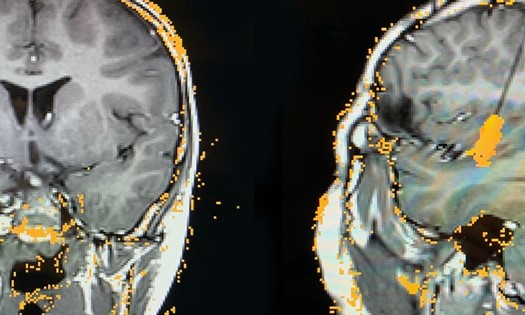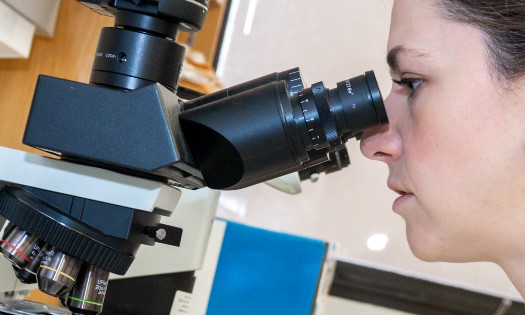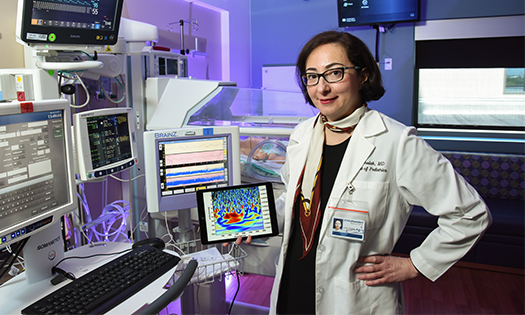When a child presents with symptoms like heartburn, vomiting and difficulty swallowing, it’s logical to assume they might suffer from gastroesophageal reflux disease (GERD). But these symptoms can also indicate a potentially more serious condition that often goes undiagnosed: eosinophilic esophagitis (EoE).
First described in the 1990s, (EoE) is an allergic reaction to specific foods. It is often accompanied by other allergies or atopic conditions, such as allergic rhinitis, asthma and eczema. If EoE is untreated, children can struggle to eat and have a hard time gaining weight. Older children with EoE can experience difficulty swallowing, oral aversion resulting in weight loss and, over time, untreated EoE can cause the esophagus to narrow.
Children’s Health℠ is home to the region’s only specialized EOE clinic — the Dallas Eosinophilic GI Diseases and Esophagitis Program (DEEP) — and our team, led by UT Southwestern faculty, sees hundreds of patients a year, many of whom have been diagnosed with GERD but actually have EoE.
“Fortunately, there are a number of treatments that help these kids manage their condition and stay on track to grow up strong and healthy, and we’re offering a clinical trial of a therapy that could give a new option to some patients,” says Christopher Parrish, M.D., who is an allergist, an Assistant Professor at UT Southwestern and Co-Director of DEEP.
Diagnosing EoE: Subtle Clues
EoE can present at any age and symptoms can vary. Infants and toddlers with EoE are likely to exhibit vomiting, reflux, fussiness and/or oral aversion. Oftentimes, these children are diagnosed with chronic reflux and put on antacid medication or proton pump inhibitors (PPIs). They may get some benefit from those options but the vomiting usually continues, and symptoms may get worse as parents introduce more solid foods.
“The biggest red flags are when feeding problems are severe, especially if they're affecting the child’s growth,” Dr. Parrish says. “If there's a patient who has had problems introducing solids, experiences chronic vomiting and/or reflux, and they aren’t progressing with feeding therapy, that’s a good point to say maybe they should be sent for an EoE evaluation.”
EoE symptoms can be milder in older children and can include heartburn and masking behaviors such as taking small bites of food and drinking frequently during meals — signs the child or teen might have trouble swallowing normal-sized bites of food. Years of chronic inflammation puts older kids at risk of food impaction. If not removed on time, this can cause rare cases of perforation of the esophagus. Long-term, children with EoE may develop fibrostenosis or stricture.
“If a provider sees these symptoms in conjunction with food allergies, environmental allergies or other atopic conditions, it would be a good idea to refer to a specialized team like ours,” says Aakash Goyal, M.D., pediatric gastroenterologist at Children’s Health, Assistant Professor at UT Southwestern and Co-Director of the DEEP team.
Diagnosis involves endoscopy and biopsy. Endoscopies often reveal telltale furrows, loss of vascular pattern, edema and rings. In the biopsy results, an eosinophil count of 15 or more per high power field of microscope indicates EoE.
EoE Treatment for Children and Teens
Physicians have three main treatment options for EoE:
Diet
Drugs, which include topical steroids and PPIs
Dilation
Many providers start with PPIs because they’re the easiest for many patients to keep up with long-term.
PPIs were originally used as a diagnostic tool for EoE. It was assumed that children who improved after an eight-week PPI course had GERD, while those who didn’t had EoE. A research team proved that omeprazole (Prilosec) also reduces eosinophil levels in some children. These findings helped researchers agree to classify PPIs as an EoE treatment rather than a diagnostic modality in 2017.
Many families will try an elimination diet in lieu of PPIs. About two-thirds of children achieve remission after ridding their diet of the dominant allergens — milk, wheat, egg, nuts, soy, fish and shellfish. Parents then reintroduce the foods one at a time, while doctors watch for symptoms and scope the patient to reassess the recurrence of disease on a particular food introduction. When this is done systematically, each food can then be labelled as “safe” or as an EoE “trigger” food.
Alternatively, doctors may prescribe swallowed topical steroids, most commonly either fluticasone or budesonide. To address EoE, children should take the budesonide in viscous form mixed with a hypoallergenic powder or a sweetener. Fluticasone, which comes as inhaler, can be swallowed after mixing with saliva. The goal with both these medications is to coat the esophagus, decreasing the inflammation at the site of the problem. This is similar to delivering the same medications to the nose to treat nasal allergies or to the lungs to treat allergic asthma. The steroid doses are small and side effects are rare.
“We’re basically just trying to get the steroid onto the surface of the esophagus, so it’s very different than if you were taking prednisone long-term to control inflammation,” Dr. Parrish says.
Still, some families are intimidated by the frequent endoscopies of the diet plan, while others don’t like the idea of steroids.
“We work closely with each family to understand their concerns and choose a treatment plan they’re comfortable with,” Dr. Goyal says.
If EoE advances far enough, the child’s esophagus can narrow and the team must endoscopically dilate it. While this makes it easier for them to swallow, the child will still have to manage their condition with diet or drugs, possibly for life.
Teamwork + A Clinical Trial for EoE
The DEEP program is home to a multidisciplinary team that includes gastroenterologists, allergists, dieticians and a child psychologist, coordinating care under one roof. All team members collaborate on decisions and schedule appointments in blocs so families can see all the team members in a single visit.
“EoE puts a lot of stress on families, so we make the process as convenient for them as possible,” Dr. Parrish says.
Our team is also constantly looking for ways to improve treatment. For example, we’re participating in a clinical trial of dupilumab, which blocks the cytokines involved in asthma or eczema. The same cytokines are involved in EoE, and early results have been promising, giving hope that one drug might treat EoE plus two common co-morbidities.
“It could be important progress for kids whose condition is so often misunderstood,” Dr. Parrish says.
Learn more about our innovative GI specialty that tackles tough challenges like EoE – every day.



